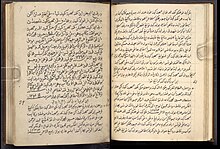 Global Information
Global InformationJawi script information
| Jawi جاوي | |
|---|---|
 Letter from William Farquhar to Sultan Muhammad Kanzul Alam, the sultan of Brunei, dated 28 November 1819. | |
| Script type | Abjad
|
Time period | c. 1300 CE to the present |
| Direction | Right-to-left |
| Languages |
|
| Related scripts | |
Parent systems | Proto-Sinaitic
|
Sister systems | Pegon script |
| Part of a series on |
| Islamic culture |
|---|
| Architecture |
|
| Art |
|
| Clothing |
|
| Holidays |
|
| Literature |
|
| Music |
|
| Theatre |
|
|
Jawi (جاوي; Acehnese: Jawoë; Kelantan-Pattani: Yawi; Malay pronunciation: [d͡ʒä.wi]) is a writing system used for writing several languages of Southeast Asia, such as Acehnese, Banjarese, Kerinci, Maguindanaon, Malay, Mëranaw, Minangkabau, Tausūg, and Ternate. Jawi is based on the Arabic script, consisting of all of the original 31 Arabic letters, and six additional letters constructed to fit the phonemes native to Malay, and an additional phoneme used in foreign loanwords, but not found in Classical Arabic, which are ca (⟨چ⟩ /t͡ʃ/), nga (⟨ڠ⟩ /ŋ/), pa (⟨ڤ⟩ /p/), ga (⟨ݢ⟩ /ɡ/), va (⟨ۏ⟩ /v/), and nya (⟨ڽ⟩ /ɲ/).
Jawi was developed from the advent of Islam in Maritime Southeast Asia, supplanting the earlier Brahmic scripts used during Hindu-Buddhist era. The oldest evidence of Jawi writing can be found on the 14th century Terengganu Inscription Stone, recorded in Classical Malay language that contains a mixture of Malay, Sanskrit and Arabic vocabularies. There are two competing theories on the origin of the Jawi alphabet. Popular theory suggests that the system was developed and derived directly from the Arabic script, while scholars like R. O. Windstedt suggest that it was developed through the influence of Perso-Arabic alphabet.[1]
The ensuing trade expansions and the spread of Islam to other areas of Southeast Asia from the 15th century brought the Jawi alphabet beyond the traditional Malay-speaking world. Until the 20th century, Jawi was the standard script of the Malay language. The use of Jawi heralded the birth of traditional Malay literature, when it was featured prominently in the royal correspondences, religious texts and literary publications. With the arrival of Western influence through colonization and education, Jawi was relegated to scripts for religious education, with the Malay language eventually adopting the Latin alphabet called Rumi in general usage.
Today, Jawi is one of the two official scripts in Brunei. In Malaysia, the position of Jawi is protected under Section 9 of the National Language Act 1963/1967, as it retains a degree of official use in religious and cultural administration. In some states, most notably Kelantan, Terengganu and Pahang, Jawi attained the co-official script status, where businesses are mandated to adopt Jawi signage and billboards. Jawi is also used as an alternative script among Malay communities in Indonesia and Thailand.[2]
Until the early 20th century, there was no uniform spelling system for Jawi. The earliest orthographic reform to develop a standard spelling was in 1937 by The Malay Language and Johor Royal Literary Book Pact. This was followed by another reform by Za'aba published in 1949. The final major reform was in 1986 under the name 'Enhanced Guidelines of Jawi Spelling' which made Za'aba Spelling as its basis. Jawi can be typed using the Jawi keyboard.
- ^ Winstedt, Richard Olaf (1961), "Malay Chronicles from Sumatra and Malaya", Historians of South-East Asia of Historical Writing on the Peoples of Asia, 2: 24
- ^ Andrew Alexander Simpson (2007). Language and National Identity in Asia. Oxford University Press. pp. 356–60. ISBN 978-0-19-926748-4.